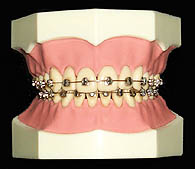
Begg orthodontic technique
1956
lightweight, low force orthodontics
In the first half of the 20th century, getting orthodontic braces on your teeth was a dramatic affair. Gold or platinum wires were attached to the teeth and would often be connected to headgear that forced the teeth into place. The method used large forces and mechanical devices to make teeth move in the desired way. The orthodontist had to make regular adjustments? this might even have required tightening a screw attached to the braces. To go through the discomfort of wearing these devices, you also needed to be wealthy enough to afford a mouthful of precious metal ? and all those visits to the orthodontist!
In the 1940s and 50s Percy Raymond Begg, an Adelaide orthodontist, developed a completely new approach to moving teeth. Rather than using large mechanical forces on the teeth, he used gentle forces in a more effective way. To do this he used stainless steel wire and worked with Arthur Wilcock, a metallurgist in Victoria, to develop the best kind of wire for the technique.
Begg?s new technique removed the need for headgear and allowed more efficient tooth movement with less discomfort and fewer visits to the orthodontist. It was also simpler and more affordable, as fewer components (and no gold or platinum) were needed. Begg caused a sensation when he published his new technique in America in 1956. By the 1960s about half of the orthodontists in the USA were using the technique.
Begg?s technique was taught and used all over the world. At the end of the century it was still being taught, and it formed the basis for refinements and advancements as new technologies arose. Teenagers around the world have Begg to thank for starting the trend towards more affordable and accessible orthodontics.
Who Did It?
Key Organisations
---
Key People
Dr Percy Raymond Begg AO : research and development
Arthur Wilcock : research and development of stainless steel wire
HD Kesling : introduced the method to the USA
Further Reading
Kesling PC, ?Begg Theory and Technique: Past, Present and Future?. In: Lysle J, ed., New vistas in Orthodontics, Lea and Febiger, 1985: 209 - 238.
Links
Animation of Begg
technique
The History of
Braces
Australian Society of Orthodontists
History
of Orthodontics
Australian Dental Association
The
Angle Orthodontist
|










